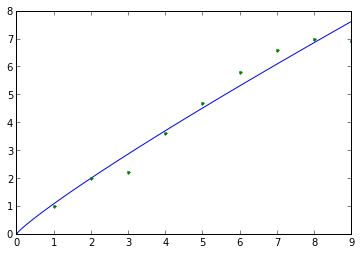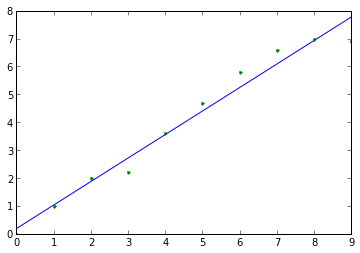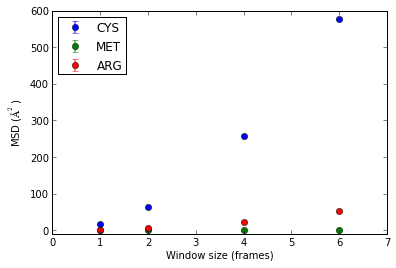Diffusion Analysis in MD Simulations¶
Authors: Tyler Reddy and Anna Duncan
The purpose of this Python module is to provide utility functions for analyzing the diffusion of particles in molecular dynamics simulation trajectories using either linear or anomalous diffusion models.
-
diffusion_analysis.fit_anomalous_diffusion_data(time_data_array, MSD_data_array, degrees_of_freedom=2)[source]¶ This function should fit anomalous diffusion data to Equation 1 in [Kneller2011], and return appropriate diffusion parameters.
\[MSD = ND_{\alpha}t^{\alpha}\]An appropriate coefficient (N = 2,4,6 for 1,2,3 degrees_of_freedom) will be assigned based on the specified degrees_of_freedom. The latter value defaults to 2 (i.e., a planar phospholipid bilayer with N = 4). Input data should include arrays of MSD (in Angstroms ** 2) and time values (in ns). The results are returned in a tuple.
Parameters: time_data_array : array_like
Input array of time window sizes (nanosecond units)
MSD_data_array : array_like
Input array of MSD values (Angstrom ** 2 units; order matched to time_data_array)
degrees_of_freedom : int
The degrees of freedom for the diffusional process (1, 2 or 3; default 2)
Returns: fractional_diffusion_coefficient
The fractional diffusion coefficient (units of Angstrom ** 2 / ns ** alpha)
standard_deviation_fractional_diffusion_coefficient
The standard deviation of the fractional diffusion coefficent (units of Angstrom ** 2 / ns ** alpha)
alpha
The scaling exponent (no dimensions) of the non-linear fit
standard_deviation_alpha
The standard deviation of the scaling exponent (no dimensions)
sample_fitting_data_X_values_nanoseconds
An array of time window sizes (x values) that may be used to plot the non-linear fit curve
sample_fitting_data_Y_values_Angstroms
An array of MSD values (y values) that may be used to plot the non-linear fit curve
Raises: ValueError
If the time window and MSD arrays do not have the same shape
References
[Kneller2011] (1, 2) Kneller et al. (2011) J Chem Phys 135: 141105. Examples
Calculate fractional diffusion coefficient and alpha from artificial data (would typically obtain empirical data from an MD simulation trajectory):
>>> import diffusion_analysis >>> import numpy >>> artificial_time_values = numpy.arange(10) >>> artificial_MSD_values = numpy.array([0.,1.,2.,2.2,3.6,4.7,5.8,6.6,7.0,6.9]) >>> results_tuple = diffusion_analysis.fit_anomalous_diffusion_data(artificial_time_values,artificial_MSD_values) >>> D, D_std, alpha, alpha_std = results_tuple[0:4] >>> print D, D_std, alpha, alpha_std 0.268426206526 0.0429995249239 0.891231967011 0.0832911559401
Plot the non-linear fit data:
>>> import matplotlib >>> import matplotlib.pyplot as plt >>> sample_fit_x_values, sample_fit_y_values = results_tuple[4:] >>> p = plt.plot(sample_fit_x_values,sample_fit_y_values,'-',artificial_time_values,artificial_MSD_values,'.')

-
diffusion_analysis.fit_linear_diffusion_data(time_data_array, MSD_data_array, degrees_of_freedom=2)[source]¶ The linear (i.e., normal, random-walk) MSD vs. time diffusion constant calculation.
The results are returned in a tuple.
Parameters: time_data_array : array_like
Input array of time window sizes (nanosecond units)
MSD_data_array : array_like
Input array of MSD values (Angstrom ** 2 units; order matched to time_data_array)
degrees_of_freedom : int
The degrees of freedom for the diffusional process (1, 2 or 3; default 2)
Returns: diffusion_constant
The linear (or normal, random-walk) diffusion coefficient (units of Angstrom ** 2 / ns)
diffusion_constant_error_estimate
The estimated uncertainty in the diffusion constant (units of Angstrom ** 2 / ns), calculated as the difference in the slopes of the two halves of the data. A similar approach is used by GROMACS g_msd [Hess2008].
sample_fitting_data_X_values_nanoseconds
An array of time window sizes (x values) that may be used to plot the linear fit
sample_fitting_data_Y_values_Angstroms
An array of MSD values (y values) that may be used to plot the linear fit
Raises: ValueError
If the time window and MSD arrays do not have the same shape
References
[Hess2008] (1, 2) Hess et al. (2008) JCTC 4: 435-447. Examples
Calculate linear diffusion coefficient from artificial data (would typically obtain empirical data from an MD simulation trajectory):
>>> import diffusion_analysis >>> import numpy >>> artificial_time_values = numpy.arange(10) >>> artificial_MSD_values = numpy.array([0.,1.,2.,2.2,3.6,4.7,5.8,6.6,7.0,6.9]) >>> results_tuple = diffusion_analysis.fit_linear_diffusion_data(artificial_time_values,artificial_MSD_values) >>> D, D_error = results_tuple[0:2] >>> print D, D_error 0.210606060606 0.07
Plot the linear fit data:
>>> import matplotlib >>> import matplotlib.pyplot as plt >>> sample_fit_x_values, sample_fit_y_values = results_tuple[2:] >>> p = plt.plot(sample_fit_x_values,sample_fit_y_values,'-',artificial_time_values,artificial_MSD_values,'.')

-
diffusion_analysis.mean_square_displacement_by_species(coordinate_file_path, trajectory_file_path, window_size_frames_list, dict_particle_selection_strings, contiguous_protein_selection=None, num_protein_copies=None)[source]¶ Calculate the mean square displacement (MSD) of particles in a molecular dynamics simulation trajectory using the Python MDAnalysis package [Michaud-Agrawal2011].
Parameters: coordinate_file_path: str
Path to the coordinate file to be used in loading the trajectory.
trajectory_file_path: str or list of str
Path to the trajectory file to be used or ordered list of trajectory file paths.
window_size_frames_list: list
List of window sizes measured in frames. Time values are not used as timesteps and simulation output frequencies can vary.
dict_particle_selection_strings: dict
Dictionary of the MDAnalysis selection strings for each particle set for which MSD values will be calculated separately. Format: {‘particle_identifier’:’MDAnalysis selection string’}. If a given selection contains more than one particle then the centroid of the particles is used, and if more than one MDAnalysis residue object is involved, then the centroid of the selection within each residue is calculated separately.
contiguous_protein_selection: str
When parsing protein diffusion it may be undesirable to split by residue (i.e., amino acid). You may provide an MDAnalysis selection string for this parameter containing a single type of protein (and no other protein types or other molecules / atoms). This selection string may encompass multiple copies of the same protein which should be specified with the parameter num_protein_copies
num_protein_copies: int
The number of protein copies if contiguous_protein_selection is specified. This will allow for the protein coordinates to be split and the individual protein centroids will be used for diffusion analysis.
Returns: dict_MSD_values: dict
Dictionary of mean square displacement data. Contains three keys: MSD_value_dict (MSD values, in Angstrom ** 2), MSD_std_dict (standard deviation of MSD values), frame_skip_value_list (the frame window sizes)
References
[Michaud-Agrawal2011] (1, 2) - Michaud-Agrawal, E. J. Denning, T. B. Woolf, and O. Beckstein. MDAnalysis: A Toolkit for the Analysis of Molecular Dynamics Simulations. J. Comput. Chem. 32 (2011), 2319–2327
Examples
Extract MSD values from an artificial GROMACS xtc file (results measured in A**2 based on frame window sizes) containing only three amino acid residues.
>>> import diffusion_analysis >>> import numpy >>> import matplotlib >>> import matplotlib.pyplot as plt
>>> window_size_list_frames = [1,2,4,6] >>> dict_particle_selection_strings = {'MET':'resname MET','ARG':'resname ARG','CYS':'resname CYS'} >>> dict_MSD_values = diffusion_analysis.mean_square_displacement_by_species('./test_data/dummy.gro','./test_data/diffusion_testing.xtc',window_size_list_frames,dict_particle_selection_strings)
Plot the results:
>>> fig = plt.figure() >>> ax = fig.add_subplot(111) >>> for residue_name in dict_particle_selection_strings.keys(): ... p = ax.errorbar(window_size_list_frames,dict_MSD_values['MSD_value_dict'][residue_name],yerr=dict_MSD_values['MSD_std_dict'][residue_name],label=residue_name,fmt='o') >>> a = ax.set_xlabel('Window size (frames)') >>> a = ax.set_ylabel('MSD ($\AA^2$)') >>> a = ax.set_ylim(-10,600) >>> a = ax.legend(loc=2,numpoints=1)
